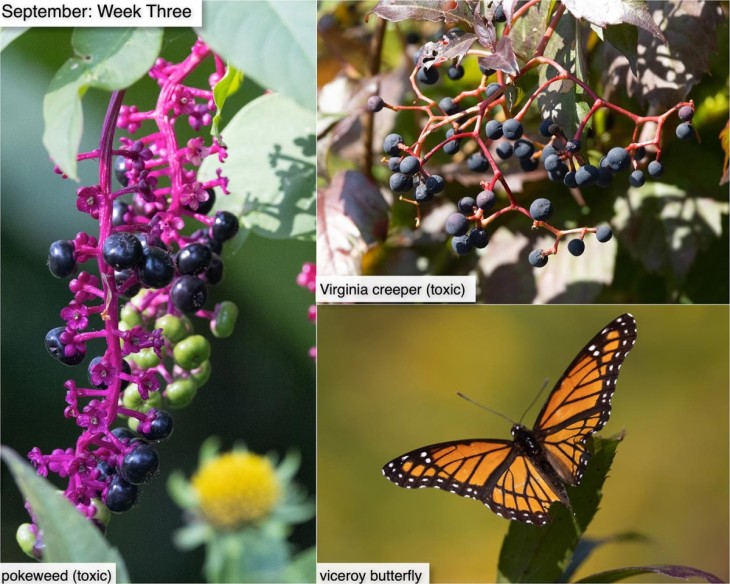This week in the woods, we’ve been noticing the abundance of brightly colored berries and other fruit. The Northern Woodlands biweekly What in the Woods is That? quiz features six types of fruit ripening now. Here are two additional ones that exhibit contrasting stem and fruit colors.
Many plants produce brightly colored fruits that attract birds, rodents, and other animals which, through consumption and defecation, help spread seeds. Some plants take this “advertising coloration” a step further by producing brightly colored foliage or stems around the fruit, making the fruit even more conspicuous. One of the most spectacular of these is pokeweed, which by now has traded its white flowers for glossy purple berries on fuschia stems. This bright coloration may be especially helpful for attracting migratory birds that are not familiar with an area and are relying on visual cues to find food.
In general, the berries of native plants are much more nutritious for migratory birds than are those of non-native species. Pokeweed berries, for example, are a common food for migrating thrushes. Virginia creeper, which displays vividly contrasting red stems and blue berries, is also a key early autumn food for birds and other wildlife. (Note, the berries of both pokeweed and Virginia creeper are poisonous for humans!) Because this vine transitions to bright red fall foliage earlier than most trees, now is the time you’re most likely to notice it. If you’re out walking on a wood edge or along a hedgerow and see an otherwise green tree with brilliant red patches, take a closer look.
Monarch butterflies are migrating, and for a moment, we thought we’d discovered a couple of them flitting around a meadow. Then we noticed the black horizontal lines on the hindwings. Viceroy butterflies closely resemble monarchs, but as shown by this helpful post from Mary Holland’s Naturally Curious blog, you can easily tell the two species apart by the viceroys’ black lines. Viceroys don’t feed on milkweed and their bodies don’t contain cardiac glycerides, but they look enough like monarchs to trick many birds. Viceroys lay their eggs on willows and poplars, and you’ll often find them late into September nectaring in goldenrod stands.
What have you noticed in the woods this week? Submit a recent photo for possible inclusion in our monthly online Reader Photo Gallery.


